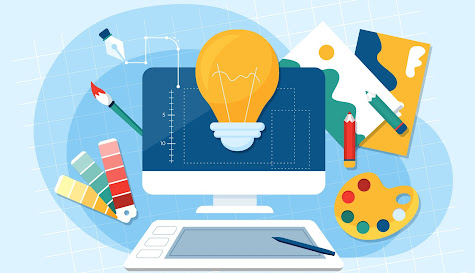12 Proven Tips to Become a Freelance Graphic Designer (GUIDE 2024)
What is a Freelance Graphic Designer?
Starting a freelance graphic design career requires a thorough understanding of the fundamentals of the industry. Designers are the primary visual message communicators because graphic design is the art of visually communicating ideas and concepts. From billboards and commercials to websites and logos, designers influence daily life's visual environment. On the other hand, freelancers work alone, creating customized solutions for customers. Their independence enables them to carve out distinct spaces in the market and showcase their own artistic visions. Making the switch to freelance graphic design offers the opportunity to make a lasting impression on the visual arts while also opening doors to a world of creativity and self-expression.
How to Become a Freelance Graphic Designer?
Discover Your Potential for Freelance Graphic Design by Following These 12 Easy Steps to Get Started on Your Creative Path Today.
(12 Simple Steps)
- Build a Creative Mind
- Define a Niche
- Create a Portfolio
- Set Your Prices
- Organize Your Workspace
- Enhance Your Skills
- Obtain the Right Tools
- Build Your Brand
- Market Yourself
- Deliver Excellent Customer Service
- Continuous Learning
1. Build a Creative Mind
If you're already engaged in this read, you've likely attached the first part. The first step toward graphic design freelance work depends on natural creativity. Creativity is essential to this journey and drives the development of a freelance graphic designer. An endless supply of creative energy is necessary in a field that is founded on innovation. Having a creative flare, whether it's a natural trait or a developed ability, helps you succeed as a freelance graphic designer.
2. Define a Niche
Choose a particular field of graphic design to concentrate on, such as web design, print design, digital illustration, branding, or typography. You can stand out in a crowded market and draw in clients looking for your specific area of expertise by specializing in it. When selecting a niche, take into account your strengths, interests, and the needs of the market. But as your career develops, stay adaptable and willing to investigate new design fields.
3. Create a Portfolio
Your portfolio serves as a visual CV that highlights your skills to potential employers. Add a range of projects, such as posters, illustrations, website designs, branding materials, and logos, that showcase your versatility and experience. Present your best work in an eye-catching, professional manner by arranging your portfolio. To make it simple for clients and employers to view your work, think about building an online portfolio website.
4. Set Your Prices
Choose your pricing strategy based on elements like the project's complexity, your experience level, the work's scope, and industry regulations. When determining your rates, look up the going rates for freelance graphic designers in your area and take your desired income, profit margins, and overhead costs into account. Communicate openly and clearly with clients regarding your pricing, including your fees, terms of payment, and any additional expenses. To satisfy customers with various spending limits and requirements, think about offering various pricing packages or options.
5. Organize Your Workspace
Create a special place where you can work on design projects with comfort and effectiveness. Select a space that is calm, illuminated, has comfortable furniture, and has enough room for you to store your supplies and tools. To support your workflow, spend money on a strong computer, a top-notch monitor, and graphic design software. To stimulate your creativity, add motivational art, design books, and decoration to your workspace.
7. Enhance Your Skills
Start by studying the principles of graphic design via tutorials, online courses, or traditional classroom instruction. With design software such as Adobe Illustrator, Photoshop, or InDesign, practice on a regular basis. Try a variety of approaches and styles to expand your skill set. Attend workshops, read design blogs, and look at other designers' work to stay up to date on industry trends. The secret to becoming a skilled graphic designer is to always improve.
8. Obtain the Right Tools
To be successful, freelance graphic designers require a wide range of software abilities. Figma and the Adobe Creative Cloud—which includes InDesign, Illustrator, and Photoshop—are essential tools. Learning these tools is essential if you want to advance in your freelance career. For organized learning, think about signing up for a graphic design course. Practice is essential, even though self-teaching and online tutorials are options. Set away time to practice these tools until they come naturally to you, which will quicken your journey to success as a freelance graphic designer.
9. Build Your Brand
Look yourself as a brand, and work to create a unified identity that represents your principles, style, and personality as a designer. Create a professional and visually appealing logo, business cards, and other promotional materials. Make a website for your portfolio to display your work and offer details about your services, fees, and contact information. Use your brand consistently on all digital and physical channels to increase brand awareness and credibility with new clients.
10. Market Yourself
Create a marketing plan to draw customers to your independent graphic design company and advertise your offerings. By consistently adding new content and projects to your blog, social media profiles, and portfolio website, you can establish a strong online presence. Share case studies, design tutorials, client testimonials, and design advice to show your expertise. Make use of search engine optimization (SEO) strategies to raise your website's exposure in internet search results and reach in organic visitors.
11. Deliver Excellent Customer Service
As a freelance graphic designer, maintaining an excellent connections with your clients is essential to your long-term success. Throughout the design process, from the first meetings to the project's completion and beyond, communicate with clients in a clear and professional manner. Pay close attention to their requirements, objectives, and criticism when you are creating your designs. Answer all of their questions, worries, and requests quickly. On time, produce excellent work, and whenever possible, go above and beyond their expectations.
12. Continuous Learning
To remain competitive and relevant in the rapidly changing graphic design industry, embrace continuous learning. Attend webinars, workshops, online courses, and industry publications to stay up to date on the most recent software updates, industry advancements, and design trends. By trying out new methods, experimenting with various media, and getting inspiration from other artists, you may expand your skill set.






Post a Comment